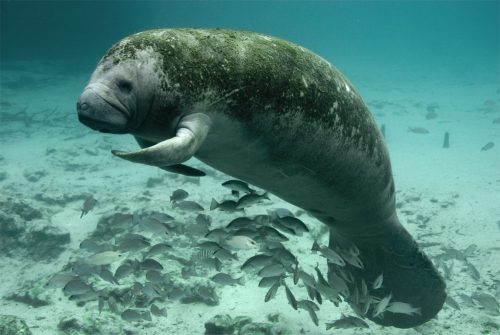The West Indian manatee (Trichechus manatus) is an aquatic mammal that is related to the West African manatee, the Amazonian manatee, the dugong, and the Steller’s sea cow which was hunted to extinction in 1768. Manatees are close relatives of the elephant and the hydrax which is a small, gopher-sized mammal. The West Indian manatee includes two distinct subspecies, the Florida manatee (Trichechus manatus latirostris) and the Antillean manatee (Trichechus manatus manatus). There are approximately 6,000 manatees in Florida according to aerial surveys conducted in 2015.
Manatees have a paddle-shaped tail and two forelimbs that act as flippers but each flipper has three or four nails, just like elephants. These nails may be useful as they “walk” along the sea bottom. If you were to take an x-ray of a manatee flipper, it would resemble a human hand. This is because manatees are believed to have evolved from a wading, plant-eating land animal. Being mammals, manatees have coarse hairs all over their bodies and whiskers on their faces.
manatee-skeleton
Adult manatees are about 10 feet long and weigh between 800 and 1200 pounds. Manatees do not reproduce until they are about five years old and usually only produce one calf after a gestation period of a year. Females may reproduce only every 2-5 years, so their rate of reproduction is very slow. At birth, calves are about 3-4 feet long weighing between 40-60 pounds and are dependent on their mother for up to two years.
manateespair
In the winter, Florida manatees reside mostly in Florida but migrate during the warmer months as far north as Massachusetts or as far west as Texas. However, they usually live in Alabama, Georgia, and S. Carolina during the summer months. Manatees can also be found in the coastal and inland waterways of Central America and along the northern coast of South America.
Gentle, trusting, and slow-moving, manatees have no natural enemies and have a potential lifespan of 60 years or more. Most of the threats they face are caused by humans. Collisions by watercraft are the number one cause of human-related manatee mortality, and it is hard to find a manatee that does not carry scars from injuries inflicted by boat hulls and propellers. Pollution and coastal development are other threats that manatees face.
Hundreds of manatees die from cold stress every year since they cannot tolerate temperatures below 68˚ F. Although they appear to have a lot of fat, manatees actually have very little fat content, which is why they are so sensitive to the cold. About 20% of their body mass is taken up by their gastrointestinal tract, which makes sense because herbivores generally have longer intestines than carnivores. The heat that is generated from the gastrointestinal tract helps keep the manatee warm in winter. Manatees, sometimes called “sea cows,” must consume large quantities of plant matter because it is generally of low nutritional value.
manatee-anatomy
Drawing by Robert K. Bonde, U.S. Geological Survey, Florida Caribbean Science Ctr, Sirenia Project – See more at: http://www.savethemanatee.org/anatomy.htm#sthash.wDW1x2x2.dpuf
In the cold winter months, they seek out warmer waters in the springs but unfortunately, due to habitat loss from residential development along with harassment by humans, there are fewer places that are safe for manatees to seek warmth. Protection of their warm water habitat is essential to the future of the manatee and their very survival as a species. They need places to seek shelter and warmth that are free from human encroachment. Whenever humans try to swim with or otherwise harass manatees, it alters their behavior and causes stress and serious harm.
manatees-at-warm-water
Manatees gather at the warm water effluent of Florida Power and Light Company’s Riviera Beach power plant. (Photo by Cynthia Taylor, Wildlife Trust) – See more at: http://www.savethemanatee.org/info_manatee_migration.html#sthash.GZO2VpLq.dpuf
Manatees are currently protected under the Marine Mammal Protection Act, which prohibits the take (i.e., harass, hunt, capture, or kill) of all marine mammals. The U.S. Fish and Wildlife Service (FWS) recently proposed the down listing of the entire West Indian manatee species from “endangered” to “threatened” under the federal Endangered Species Act, a move that does not seem justifiable since by their own admission, “population trends are declining or unknown in 84 percent of the countries where manatees are found.” The FWS is apparently basing their decision on a computer model that does not take into consideration two recent catastrophic episodes between 2010-2013 in which hundreds of manatees died due to extended cold spells and toxic red tide blooms. Nor does the FWS address habitat loss due to waterfront development in its plan to down list the manatee.
Our Florida manatee deserves to have full protection and plans in place to ensure their future survival. More than 60% of manatees rely on artificial warm water sources such as power plants, and these are in danger of being taken away with no plan in place to ensure that they have alternative sites to seek warmth. Education of boat operators and enforcement of speed limits in manatee zones are also important components of manatee survival. Together, we can help these gentle giants to survive by doing all we can to keep protections in place for this unique, iconic Florida species.
References and Resources:
http://www.savethemanatee.org/
http://www.savethemanatee.org/aa_fws_downlisting_1-16_alert.html
http://www.defenders.org/florida-manatee/threats
Click to access 2015-32645.pdf
https://www.facebook.com/savethemanateeclub/?fref=ts&ref=br_tf
http://www.huffingtonpost.com/2013/08/01/manatee-photos-manatees_n_3678051.html
http://www.orlandosentinel.com/opinion/os-ed-save-manatees-katie-tripp-the-interview-20160222-story.html

